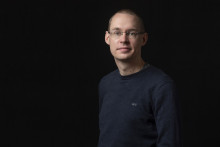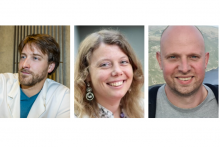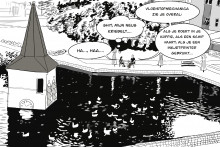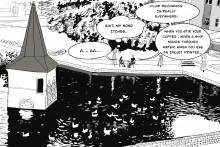At first glance, it might seem that we know everything we need to about how things melt and dissolve. Put an ice cube in your drink, it will change shape and eventually disappear. It turns out, however, it is not that simple. Especially once turbulence is involved – and it is almost always involved, explains Sander Huisman, assistant professor in the Physics of Fluids group at the University of Twente. He received the ERC Starting Grant for research into ‘understanding the melting dynamics in turbulent flows’.
ERC Starting Grants
The ERC Starting Grants are designed to support early-career researchers who are starting their own independent research team or programme. The success rate of receiving the grant was 9,8% this year. Out of nearly four hundred grants awarded this year, 44 went to scientists in the Netherlands, including three at the UT: Christoph Baeumer, Nienke Bosschaart and Sander Huisman.
Turbulence
‘Generally speaking, all my work is related to turbulence. This means studying heat transfer, mass transfer or momentum transfer in turbulent flows, for example,’ says Huisman, adding that turbulence is certainly more than just an unpleasant experience on an airplane. ‘Turbulence is everywhere. It’s in our blood, in our tea and coffee, in the wind that moves around you when you walk, in oceanic currents, smoke rising from a chimney, flows surrounding cars and planes, and so on. All of the usual flows are turbulent.’
Not only is turbulence literally all around us, it is also a research topic full of unanswered questions, says the UT scientist. ‘There are no easy answers. Yes, we have computational methods to simulate turbulence, but there are problems in turbulence that are very hard to model or simulate. Experimental physics is needed to study it – which is what I’ve been doing throughout my career.’

Sander Huisman
From: the Netherlands
Studied: Physics, University of Twente
Current position: Assistant Professor
Works at: Physics of Fluids group, Faculty of Science and Technology (TNW), University of Twente
ERC Project: MELTDYN - ‘Understanding the melting dynamics in turbulent flow’
Rough surface
One of the unanswered questions surrounding turbulent flows is how they influence melting rate. To explain better, let’s go back to the image of an ice cube in a glass of water. ‘Intuitively, most people assume that ice cubes become rounder and rounder, smoother and smoother as they melt,’ says Huisman. ‘However, it turns out that once turbulence is involved that is not the case. Once turbulent flows are involved, it appears that these melting surfaces become rougher, not smoother – which is very counterintuitive, even for me!’
‘Look at icebergs or ice caves,’ continues the assistant professor. ‘If you look, you’ll see they are sort of dimpled on the surface, they are covered with these dimples, so called scallops. Even meteorites entering the atmosphere are full of similar structures called regmaglypts. And we observe the same phenomenon on all different scales – from large icebergs to blocks of dissolving sugar. Why is that? Is there some fundamental mechanism that dictates it and that we aren’t aware of? This has of course been observed by other scientists, I haven’t discovered that; but we still don’t know what influence these dimples have on the melting rate and on the turbulence. And that is what I aim to explore.’

Scallops (dimples) on the surface of an ice cave
Melting rate
Sander Huisman’s project will look into how these patterns form, how they evolve and how they impact the melting rate. The research findings could have many potential applications. They could help us better predict how fast icebergs and glaciers are melting, they could improve chemical reactors and the food industry, where they might help us predict exactly how long it takes to dissolve salt or sugar. ‘Given the societal relevance of climate change and the burning technological challenges, the project is of utmost importance and extremely timely,’ believes Huisman.
The UT scientist has received €1.5 million from the European Research Council, a sum that will largely be used for hiring new researchers. ‘We already have all the facilities we need at the UT,’ explains Huisman. ‘I’m planning to use five different setups for my experiments. These will include, for example, water channels with ice and sugar surfaces, so that we can observe how the dimples form and evolve. A big advantage is that all the setups are also salt-proof. This is important, because so far nobody has really looked at the influence of salt on melting. This knowledge could have big consequences, just think of icebergs surrounded by sea water and applications in industry.’

Unexplored topics
The project is scheduled for five years. What should we expect at the end of this period? ‘My ERC project doesn’t have any specific deliverables,’ answers Huisman. ‘These projects are supposed to be ‘high risk, high gain’, so there is of course a possibility for failure. The research is really exciting. Of course I hope we’ll be able to predict the formation of the dimples and the melting processes. That would be the expected outcome, so to speak. However, it would be even nicer if we discovered something unexpected. There are a lot of unexplored topics covered in this project, a lot of aspects people didn’t look into yet.’
'There are a lot of unexplored topics covered in this project'
‘This grant is a really big deal for me,’ stresses the UT scientist. ‘I was of course extremely happy to get it. The announcement was supposed to be made mid-December. I was very anxious and kept checking the results online when I was on holiday. Eventually, the results were released while I was on a flight. I landed, I was jetlagged and tired and suddenly people were calling me and asking if I got it. The first thing I did was send out a thank you email to like fifty people who have helped me along the way. This is the first grant I received as the main and only applicant. It’s nice to have this external validation of my ideas and expertise.’








